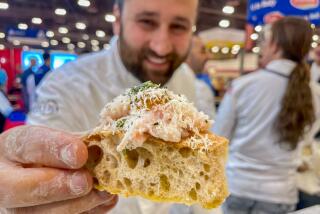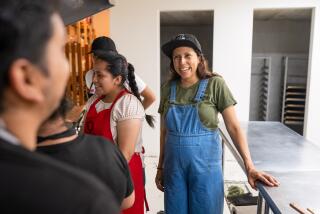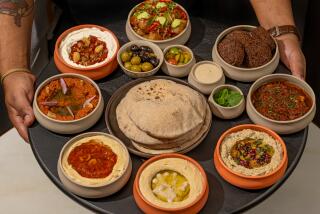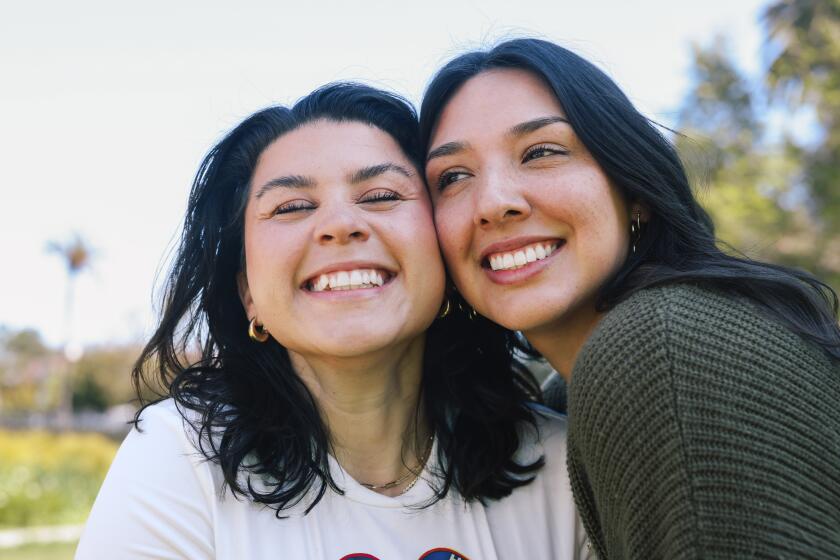Italian Spoken Here
The cab squirts past a blur of interesting-looking shops, overshoots the address, makes a neat U-turn and deposits us in front of a window with the word Ladro (“thief” in Italian) scribbled in red. We’re in Fitzroy, one of Melbourne’s inner-city neighborhoods. A short cab ride or a brisk walk from the City, the downtown business district, it has the same boho vibe as Los Feliz or New York’s East Village. Ladro is one of the hottest restaurants of any ilk in Melbourne, and that’s saying something because this town is passionately devoted to the art of eating well. The weather is similar to San Francisco’s, which could be a factor. Melbourne is also an arts center, so design too is important in restaurants, wine bars and cafés.
Ladro’s storefront space features an L-shaped bar with a massive bouquet of flowers, a maitre d’ in a gold-stenciled Martin Margiela T-shirt and a busy wood-burning oven. Everyone crowds in at the long communal tables, as more people storm the door or wait outside on the sidewalk. The menu and specials are scrawled on a white subway-tile wall—a handful of appetizers and salads, a dozen pizzas and the roast of the night. From the dining room, you can see into the kitchen, under the command of Rita Macali, a fierce-looking beauty who is Ladro’s chef and co-owner.
Pizzas from Ladro’s wood-burning oven are thin-crusted and handsome. There’s a Margherita, of course, but also Badabing, which has pork sausage, provolone, oregano and fresh hot pepper, and Phat, lavished with fresh mozzarella (straight from Campania), prosciutto and wild arugula. Molten and blistered, the pizzas arrive with a wheeled cutter so you can serve the slices yourself.
Follow—or not—with the roast of the night. It might be quail roasted with potatoes, succulent capretto (baby kid) or porchetta (suckling pig), depending on what the farm that supplies the restaurant has at the moment. In a few weeks, our waiter explains they’ll have abbacchio, thereby just about breaking my heart. That’s the exquisite milk-fed baby lamb Italians are crazy about, especially at Easter. Now I wish I’d delayed my trip a few weeks. The dessert that night is an organic fruit plate, which doesn’t sound exciting, but the devil is in the details—sliced kiwi, fragrant melon and, get this, grapes from a vine that grows over somebody’s garage.
After dinner we head across the street to the Gertrude Street Enoteca for a glass of wine and, much later, an espresso. The enoteca is a dishy little place—part wine shop, part wine bar and café—serving excellent cured meats, cheeses and panini. A few tiny tables are moored in front of shelves holding wine, amari, digestivi and the occasional cookbook or Jonathan Franzen novel tucked among bottles of sauce and jars of preserved lemon.
Co-owner James Broadway, a wine importer who is active in Melbourne’s Slow Food chapter, knows his stuff and offers a small but shrewd collection of top-notch Italian, French and Austrian labels mixed in with some interesting Australian producers. It’s such a terrific place to hang that I return the next day for lunch, when his partner, Brigitte Hafner, a chef who writes recipes for the Sydney Morning Herald, helps out with a short menu of simple dishes.
I love the enoteca’s quirky aesthetic: Behind the bar is a giant blackboard with Elizabeth David’s recipe for duck with figs written out in a lovely hand, and from the ceiling hang Spanish hams and prosciutto, branches of bay leaves, dried red peppers and braids of garlic. And those bottles of sugo? They’re left over from a Slow Food event where tomato sauce was cooked up in big cauldrons the old-fashioned way.
See what I mean? Melbourne is really into the Italian thing.
Food in Australia isn’t just one cuisine. Immigrants to the remote continent brought with them their recipes and traditions along with their trunks of clothes and memories. Melbourne, the capital of Victoria in southeast Australia, is a multicultural mix of immigrants from 140 nations. In the years after World War II, Italians arrived in great numbers.
Melbourne’s restaurants encompass so many cuisines, you could go around the world in 80 days. The strongest, though, is, Italian. I’m not talking red-sauce Italian or the mom-and-pop places you find in New York’s Little Italy. In this city of 3 million, a new generation of chefs and restaurateurs has broken out of the ‘hood. Well traveled and no slouches in the culinary research department, Melbourne’s chefs are turning out Italian cooking soulful enough to rival the mother country’s.
An Australian wine importer had shared with me a few of his favorite spots, including Becco, where he said he could eat every night. I’d already discovered it my first day in Melbourne, when my paramour (otherwise known as my husband, Fred) and I had walked all over the city in a vain attempt to stave off jet lag. At one point we found ourselves in a narrow lane lined with galleries, boutiques and an Asian restaurant with the delicious name Madam Fang. Next door was Becco, a string of storefronts cobbled together with an open kitchen at the back. At 3 in the afternoon people were still lingering over lunch. How great is that?
Elizabeth Egan, its co-owner and chef, is an intelligent, sensual cook who turns out char-grilled quail wrapped in pancetta on a cushion of rösti potatoes or a supple swordfish carpaccio embellished with orange and pepper. She might sauce trofie (Ligurian corkscrew pasta) with slivered white anchovies, broccoli, capers and a squirt of lemon to create a tapestry of salty and sour. Roast duck really tastes like duck, its flavor set off by a Muscatel and grappa sauce. I loved the lamb loin with smashed cannellini beans too. Dessert was a dreamy plum crostata with mascarpone ice cream or tiramisu spooned out in a loose oval dusted with cocoa and swathed in an espresso sauce decorated with coffee beans. If I hadn’t already made reservations elsewhere, I would have come back the next night to try the rest of the menu.
The next day we take the tram to the beach neighborhood of St. Kilda. (Melbourne is made up of a series of linked villages or neighborhoods.) The object? Lunch at Café di Stasio. My various informants had given this long-running Italian mixed reviews, which upon further investigation seemed to have more to do with the flamboyant personality of owner Ronnie (Rinaldo) di Stasio than the food. He wasn’t there that day, so I can’t judge. But I definitely appreciate the café’s theatrical setting, with dark blinds filtering out the sea light and extravagant Venetian plastered walls hung with pale masks.
At lunch, the $25 prix fixe menu is a steal for two courses, dessert and a glass of wine. You can have spaghetti all’ amatriciana, followed by calamari and peas in a fresh tomato sauce, for example. But the pasta courses on the regular menu are just too tempting to pass up: maltagliate (“badly cut”) pasta flecked with parsley and tossed with braised scallion, bitter radicchio and sautéed calamari, or linguine with plump, intensely delicious coral prawns and their roe. We round off our lunch with lamb braised in white wine, anchovies and rosemary. And, of course, an espresso. Melbourne’s Italian restaurant scene was swimming into focus.
Sophisticated and serious. Just like the coffee.
Order an espresso almost anywhere in Melbourne and it’s superb—short and strong with the right amount of crema, or foam. Better than in Italy in many cases. I would leave my hotel, walk in any direction and have a choice of stylish cafés where the barista knew how to make a terrific espresso or macchiato.
You also can get slabs of toast with good butter and splendid jam, along with fresh copies of newspapers and magazines. After only a few days in Melbourne, I already had some favorites—Pellegrini, for example, an espresso bar in the heart of the city that hasn’t changed much since the ‘50s, and Il Solito Posto in the downtown business district.
One morning I take the Elizabeth Street tram to the covered Queen Victoria Market, which is on 17 acres of land that Queen Victoria gave to the city more than 125 years ago. A 10-minute ride from the city center, the market draws shoppers from all corners, and no wonder.
The minute I step off the tram, the smell of roasting coffee draws me into Coffea Coffee for yet another delicious macchiato. This tiny shop sells coffee beans and all sorts of coffee paraphernalia, espresso machines and parts. We end up staying for lunch. Coffea has two chefs who prepare a small menu exclusively from ingredients from the market, things such as panini with eggplant tapenade and slices of hard-boiled egg, and cabbage salad with thinly sliced porchetta and apple. For dessert, there might be ricotta cheesecake with fresh figs, and castagnaccio, the Tuscan chestnut-flour cake.
Queen Victoria Market goes a long way toward explaining why Melbourne restaurants are so good. People here cook, and the quality of the ingredients is exceptional, especially the seafood. Some of the market’s fishmongers are fourth generation, and their stalls display the bounty that comes from Australian waters—beautiful blue swimmer crabs, octopus and calamari the size of a thumbnail, huge prawns and those Moreton Bay bugs, primitive-looking saltwater crustaceans with sweet, succulent flesh. One stall sells only Australian cheeses and big slabs of butter that have varying degrees of saltiness. There are Australian, Vietnamese and Italian butchers to choose from, stands selling poultry and game, crocodile meat and “peppered roo,” and freshly made pastas or Polish-style sausages.
The produce aisles go on and on, with sections devoted to exotic tropical fruit or organic produce. My favorite stand? The one selling all sorts of wild mushrooms run by a purveyor-enthusiast who leads mushroom hunting tours in the nearby wine country.
The seasons are the opposite of ours, and chefs seemed attuned to the changes. Think about it: Christmas takes place in what is their summer, when a cold seafood banquet sounds a lot more appealing than a roast turkey dinner. Because it was May—their fall—when I visited Australia, the roast suckling pig at Il Bácaro sounded appealing, especially if you could drink a Barolo with the pork. Small and intimate, Il Bácaro has been called the sexiest restaurant in Melbourne, and it does have that sexy city vibe—its ruthlessly efficient waiters could stand in for Armani models.
The wine list is filled with famous Italian bottles at breathtakingly high prices. (That’s pretty much the case everywhere in Melbourne because all wines, even domestic ones, are taxed at more than 40% wholesale.)
I didn’t expect to eat as well as I did here. How can you not be seduced by brassy gold zucchini flowers stuffed with molten bocconcini and anchovies, or a rustic salad of toasted bread, cherry tomatoes—and turnips.
And I couldn’t pass up the chance to try spaghettini with Moreton Bay bugs. Roast duck in vin santo was delicious too, but the roast suckling pork was something else again, with a crackling, crisp skin and marvelous pink flesh. The food was direct and simple, rustic and sophisticated at the same time.
Then there’s Da Noi—”Our Place.” A friend who’d been to Melbourne the month before had raved about this soulful Sardinian restaurant. And like him, I fell hard. There is a menu, but nobody really consults it. The idea is to put yourself in the hands of one of the engaging and opinionated waiters, who will query the diners about relative states of hunger and likes and dislikes before bringing out a parade of dishes. My Australian friend Sue calls it an “interactive” restaurant.
Da Noi occupies a diminutive two-story space in the middle of chic South Yarra, which is on the south bank of the Yarra River dividing Melbourne. One night four of us slip into a corner table just outside the kitchen, which is exactly where you want to be, within eyeing distance of the antipasti of grilled vegetables on the sideboard. It’s all very homey and hungry-making. Stracciatella, the Italian egg drop soup, arrives in a shallow bowl laced with emerald spinach and bite-sized pieces of quail in a rich, nourishing broth. Then comes tagliatelle with mussels, clams and sweet crab legs, which really should be described as shellfish with noodles, instead of the other way around. The meat course is a luscious brasato of beef braised in cinnamon with a sauce so dark it looks like chocolate. Divine. After a plate of three simple desserts, we are sated. There is just one disappointment that night—no porchetta, their most famous dish. But then, that’s a good excuse to go back.
For dinner my last night, I waver between Grossi Florentino, the city’s most elegant Italian and an institution, or Mo Mo, the benchmark for Melbourne’s other strong suit, modern Middle Eastern cooking. Grossi Florentino is ultra-expensive, but that’s not what makes me decide on Mo Mo. Frankly, after eating Italian for lunch and dinner five days in a row, I am longing for something else. And how can I pass up the chance to try a genre we don’t have in Los Angeles?
I couldn’t have been happier. Everything about our meal at Mo Mo is thrilling, from the yeasty Moroccan bread dusted with spices to the brilliant breaded, fried chicken liver with aioli to the quail stuffed with aromatic rice. Salmon tartare is pounded with shallots and bulgur wheat until it resembles raw lamb-and-bulgur kibbeh nayyeh. There is a sumptuous pigeon bestila too, in a drift of powdered sugar. And for dessert, crème brûlée with dates tucked in at the bottom. Before I leave for the airport the next day, I race to the bookstore to pick up copies of chef Greg Malouf’s two cookbooks.
Australians are a lot like Americans, and like us, nobody eats the same cuisine day after day. Why would you, when you can dip into Greek or Lebanese one night, Vietnamese or Chinese the next, and always come back to the comforts of Italian?
I’m not through with Melbourne’s Italian restaurants. Not yet. I have to come back for the porchetta at Da Noi and the abbacchio at Ladro. And I do want to spend an evening at Grossi Florentino in that second-floor dining room with the murals and stained glass. It’s hard to believe you can find such authentic, soulful Italian cooking thousands of miles from the mother country. But it’s true. That’s the beauty of it.
GUIDEBOOK
Seriously Italian
Telephone numbers and prices: The country code for Australia is 61, the city code for Melbourne is 3. All prices are approximate and computed at a rate of $1.31 Australian dollar to one U.S. dollar.
Getting there: Qantas offers nonstop flights from Los Angeles International Airport to Melbourne; connecting service (change of planes) is available on Qantas, Air New Zealand, Cathay Pacific and Thai Airways; direct (stop, no change of planes) service is offered on Air New Zealand.
Where to eat: Becco, 11-25 Crossley St., 9663-3000. Main courses: $25 to $28.
Café Di Stasio, 31 Fitzroy St., 9525-3999. Prix fixe lunch $19; main courses, $26 to $33.
Coffea Coffee, 521 Elizabeth St., 9326-6322.
Da Noi, 95 Toorak Road, 9866-5975. Bring your own wine on Mondays. Fixed menu: $53.
Gertrude Street Enoteca, 229 Gertrude St., 9415-8262; https://www.gertrudestreetenoteca.com . $5.95 to $11.
Il Bácaro, 168-170 Little Collins St., 9654-6778. Main courses $25 to $27.50.
Ladro, 224 Gertrude St., 9415-7575. Pizzas: $10 to $13.50.
Mo Mo, Basement, 115 Collins St., 9650-0660. $16 to $30.
Market: Queen Victoria Market, 513 Elizabeth St., 9320-5822.
Where to stay: Hotel Lindrum, 26 Flinders St., 9668-1111, fax 9668-1199, https://www.hotellindrum.com.au . Doubles $164.
The Como, 630 Chapel St., 9825-2222, fax 9824-1263, https://www.mirvachotels.com.au . Chic contemporary hotel with top-notch staff and breakfast. Doubles from $195.
The Prince, 2 Acland St., 9536-1111, https://www.theprince.com.au . Doubles from $233.
The Lyall Hotel & Spa, 14 Murphy St., 9868-8222, fax 9820-1724, https://www.thelyall.com.Very comfortable small hotel on a quiet side street. One-bedroom deluxe suite, $380.
S. Irene Virbila is The Times’ food critic.
More to Read
Sign up for our L.A. Times Plants newsletter
At the start of each month, get a roundup of upcoming plant-related activities and events in Southern California, along with links to tips and articles you may have missed.
You may occasionally receive promotional content from the Los Angeles Times.






